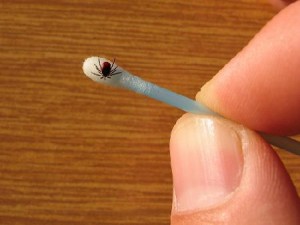Why tick control is important
Tick control – how it works
Tick checks
Veterinary licensed tick-control products
Safety precautions
Natural alternatives
Why tick control is important:
Tick checks.
Ticks are an increasing problem worldwide, and that includes the UK.
Their bites can cause irritation • lead to abscesses • transmit several diseases.
Research has demonstrated that the number of ticks in the UK carrying Lyme disease plus other infections is much higher than previously thought, and that many dogs have ticks attached, often without the owner’s knowledge. This means that the potential for undiagnosed tick-borne diseases are on the increase.
Ticks can be found where wildlife and livestock graze and where vegetation, (e.g. grasses, heather, bracken, trees or garden shrubs) is sufficiently dense to provide a higher level of humidity for ticks to thrive. This can include town parks and gardens.
Whether you have a cat, dog, horse, pony, or keep exotic animals that have access to the outdoors, your animals may be at risk from tick attachment and bites.
“Only dirty pets get ticks” is a myth. Pets having ticks latch-on has nothing to do with how clean they are, or how clean their home. Ticks do not care if their target host is an animal or person, all they are interested in is sourcing a blood meal.
Ticks are more abundant in late spring to early summer, and again during autumn. However, they are known to enjoy year round activity.
Tick control – how it works
Understanding how tick-control products work will also help you to keep your pets protected against tick bites, and the complications that can result from them.
A tick-control product can work in a number of ways:
1. It contains an ingredient that helps prevent ticks from being attracted to your pet – a repellent.
2. It contains an ingredient that kills the tick once it has made contact with your pet’s skin – an acaricide.
3. It contains an ingredient that reduces the risk of the tick attaching and taking a blood feed.
Tick-control products can work in just one of these ways or in a combination. We provide details of various veterinary-licensed products and how they work.
As some products can take a while to work after application and may kill ticks during the feeding process, it is still advisable to check your pet for ticks and to remove them even if they are dead. Make sure you visit our page on correct tick removal to get up-to-date, official advice as incorrect tick-removal methods can increase the likelihood of infection.
Tick treatments come in various forms (e.g. spot-on, spray-on or chemically-treated collars). These may be unsuitable for pregnant or nursing animals and should only be used on healthy animals and under veterinary guidance. Not all products are safe for every type of animal and some may have side- effects. Cases of poisoning may occur when people mistakenly use a product on their pet which is intended for another type of animal. That’s why it is always advisable to talk to your vet so that they can advise you what the best product for your animal is, taking into account what other pets you may have at home.
It is also important to note that there are combination products available which treat various parasites (such as worms and fleas) but some may not be suitable for the control of ticks. Make sure you have checked which type of parasite a product treats before selecting it and, if you are dissatisfied with a product, talk to your vet about alternatives.
Training your pet from an early age to let you examine it will help in many areas of its health, such as checking for injuries as well as looking for fleas and ticks.
Tick checks
Ideally, tick checks should be performed daily to reduce the risk of infection. Sub-adult ticks can be very tiny (less than 1mm), even when fully engorged with blood. Stroking your pet is a good time to do a finger-tip search for smaller ticks and this can be a relaxing, bonding time between you and your pet.
When grooming, brush against, as well as with, the hair-growth to see any ticks that are close to the skin. Check around and inside the ears, around the eyes, on the chin and around the muzzle, as well as between pads and toes.
Horses and ponies can pick up ticks while they walk through vegetation, so even stabled animals should be checked. Whilst ticks can be found anywhere on the body, favorite placed often include inside the ears, under the forelock and mane, around nostrils and muzzle, around the fetlocks, chestnuts, buttocks and the dock of the tail.
Veterinary licensed tick-control products
There are a number of products licensed in the UK for tick control on companion animals:
ADVANTIX spot on
CERTIFECT spot on
FRONTLINE spray & spot on
PRAC-TIC spot on
PROMERIS spot on
SCALIBOR COLLARS
SERESTO COLLARS
BRAVECTO
EFFIPRO DUO
EFFIPRO spot on
ACTIVYL TICK PLUS
FLEVOX spot on solution,flea and tick
VETUK spot on solution, flea and tick
BROADLINE spot on solution flea and tick
XENEX spot on solution flea and tick (rabbits and other small animals)
NEXGARD chewable treat flea and tick for dogs only
Safety precautions
All of these products must only be used on healthy animals and under veterinary guidance. Some products that are suitable for use on one type of animal can be harmful to others, causing acute illness and even death. Some products may also be unsuitable for use with pregnant or nursing animals. Always read the manufacturers’ instructions carefully before applying any product to your pet.
NEVER use more than one parasite-control product at a time without veterinary guidance, as this can result in overdosing or interaction between chemicals which could be extremely detrimental to the health of your pet.
Tick- and flea-control products that are sold over the counter in pet shops and supermarkets often contain Permethrin, which is extremely harmful to cats. It can cause Feline Permethrin Toxicosis, which is potentially fatal. Cases of poisoning most commonly occur when people mistakenly use a product that is intended for dogs on their cat. Poisoning can also occur when the cat comes into contact with treated carpets, other soft furnishings and pet bedding. Sometimes cross-contamination occurs when a cat has close contact with a treated dog.
Some product ingredients may be dangerous to aquatic organisms. Check the manufacturers’ instructions before letting your pet come into contact with water.
Natural alternatives
Some people prefer not to use chemical-based products on their pets. In some cases, the animal has an allergy to the active ingredients in these products. In either case, without using an alternative, the animal remains unprotected.
There are a number of herbal products on the market. However, most of these products have not received the rigorous trials that licensed products have. It is therefore important that pet owners thoroughly research any products that they consider using. Many herbal products can be toxic to varying degrees. Just because the products says it is ‘all natural’, it doesn’t mean that it is safe.
Speak to your vet about the most appropriate treatment for your pets.
References
1. Estimating Lyme disease risk using pet dogs as sentinels. Comp Immunol Microbiol Infect Dis. 2012 Jan 16.
2. Prevalence, distribution and risks associated with ticks infesting dogs. Veterinary Entomology (Mar 2011) 25, 377–384





